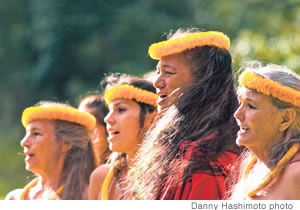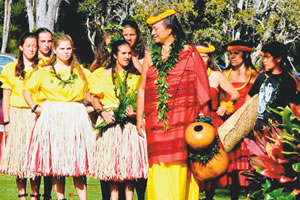The Gift Of A Culture

Sabra Kauka chants at a recent performance
Eho’omau (to perpetuate) the Hawaiian culture through education is kumu Sabra Kauka’s main mission in life. In an attempt to preserve a culture steeped in nature and love for the ‘aina, she devotedly shares her Hawaiiana knowledge with Kaua’i keiki and serves as one of the Island’s native practitioners.
“We have sustained ourselves in these islands for over 1,000 years by practicing certain values based on respect for the earth and all living things,” she says one day between classes at Island School, where she teaches.
They are life-sustaining values Kauka plans to pass along to the next generation.
A graduate of Kamehameha Schools, Kauka wasn’t even allowed to converse in her native tongue there.
“We could sing or pray in Hawaiian, but we were not encouraged to speak it,” says Kauka, whose life partner is Kai’opua Fyfe. “It’s hard to imagine a time when that was.”
And yet it was a mere 20 years ago when Kauka first entered into the field of education. Schools such as the University of Hawaii were hardly emphasizing Hawaiiana, let alone awarding Hawaiian language bachelor’s and master’s degrees as UH does today.
“We are very much at that stage in our culture where, if we don’t teach it, if we don’t practice it, we will lose it,” Kauka says.

Sabra Kauka at Island School's garden, where she is growing sweet potatoes with her students
Today, immersion schools such as Kawaikini in Lihue are integrating the language into the curriculum and increasing knowledge of Hawaiian culture, which Kauka says she is thrilled to witness.
“The language lives in the culture,” says Kauka, who also works for the Department of Education coordinating Hawaiian studies with Kaua’i kupuna.
Now the children “know who they are; they have an identity to this place,” she says. “They know where they came from and their role in life.”
Kauka wasn’t always so absorbed in education.
In fact, she originally rejected it as a child when she saw how much work teaching entailed.
“The dining room table was always covered in projects she was working on,” says Kauka of her mother, Sarah, who taught elementary school on Oahu.
Her initial dismissal of the career took her to the Mainland, where she spent some 20 years as a free-lance photojournalist working for publications such as Time, Life and National Geographic.

Colby Barth, Puakenikeni Kaeo and Lucky Bonanno, students of Kauka, hold sweet potatoes they grew
Even though she never considered a career in journalism before, as an anthropology major the work managed to combine her interest in people and places. Some of her favorite assignments were accompanying a geology class to the Yukon oil pipeline and drifting down a river for a week visiting the villages for native art festivals.
However, the tides eventually turned after Kauka stepped into a country store in the Alaskan bush while on another assignment photographing salmon. A newspaper headline regarding the poor conditions of native Hawaiians caught her eye.
“As I read, I realized that I didn’t know that things were so bad here at home,” says Kauka, whose daughter Mehana Perez is a teacher in Arizona, and son Palani McCracken works as a mason for Sorenson Construction. “I was shocked to learn that we have the highest population as far as high school dropout rates, teenage pregnancy and diabetes are concerned. I made a silent promise to myself to do something about that.”
What also startled her was the lack of educational opportunities offered to Hawaii’s youths.
“Education was highly emphasized in my house. It was never a question of if we would go to college, it was always assumed that we were going to college,” says Kauka, the grandmother of four boys. “I didn’t realize at the time that that was the exception rather than the rule. I also didn’t realize that it was highly unusual for my parents to have graduated college in the 1930s.”

Native culture radiates in plants, says Kauka
Though she was born on Oahu, when she returned to Hawaii Kauka came to the island of Kaua’i because of “its sense of community and because this is a place where you can really make a contribution,” she says.
After freelancing for a few years and working as a public information officer for then-Mayor JoAnn Yukimura during the first two years of her administration, Kauka found the work exciting but not quite what she wanted to do.
Her career path eventually led to the Department of Education, and by 1995 she found her way to Island School, where she currently teaches Hawaiian studies.
Not only does she teach Hawaiiana to children from kindergarten through fifth grade, Kauka also teaches hula to high school students at the Lihu’e school.
“You don’t just teach dance, hula or technique. You teach values of culture, of Hawaiian culture,” says Kauka, who also volunteers with the Na Pali Coast Ohana and serves on the Garden Island Resource Conservation and Development board.
The culture even radiates in every bird and plant, and Kauka makes a concerted effort to instill the importance of nature in her studies, regularly setting aside time with the children to observe the outdoors from behind Frear Center ,where they attend class.

Sabra Kauka with members of the Island School hula halau
“They love to come out on the railing and just watch the life around us,” Kauka says of her students, adding that they especially love to see the native birds such as the ‘alae ‘ula, ‘alae keokeo, Koloa maoli, nene and kolea.
The Hawaiians had strong powers of observation and were exceptional scientists because of it, she says. They were aware of nature and its importance, down to the various ocean and air currents, seasons and moon phases.
“This island is such a special place,” Kauka says. “We have such unique flora and fauna here that you don’t see everywhere. I want our children to take care of it and not take it for granted.”
She even makes sure to teach the children the Hawaiian names of mountain peaks, rivers and fishing holes, because “they’ll know their place and where they came from so they will malama or take care of them,” she says.
For example, Mount Makana on the North Shore, commonly referred to as Bali Hai, means a gift, she says.
“Why is this mountain a gift? Because there’s a gift of rain in Ha’ena, Ke’e and Limahuli – the gift of life,” she says. “Those valleys, that part of the island, supported many, many people. It still does. Everything was produced there – it came from the reef, it came from the land and the sea.”
Maintaining the culture through language is something Kauka does when she conducts Hawaiian blessings.
Raised in a Hawaiian home, she grew up listening to prayers, blessings and songs and is often called upon by the community to continue these traditions.

To teach hula, says Kauka, you must teach the culture
“People who are in dire straits with this economy who ask for blessings, it’s my pleasure and honor to go to bless their home or land or business, or them,” says Kauka, who also volunteers her time conducting ceremonies for native animals. “I have scopes of knowledge, big faith and I’m close to the land.”
Being close to the land is a seemingly forgotten trait, but Kauka hopes it will soon be remembered.
“I would really like to see people understand the beauty of this place and how tenuous it is, and how, as the population grows, that we expand wisely, that we use conservation practices,” she says. “When you fly into Honolulu you see all these houses coming up on the Ewa Plain – that’s prime agriculture land. I like the sense, here on Kaua’i, of the consciousness of sustainability. You may be really tired of that word, but if you don’t think about it and we don’t practice it and do it, we’re not going to be here much longer.”



